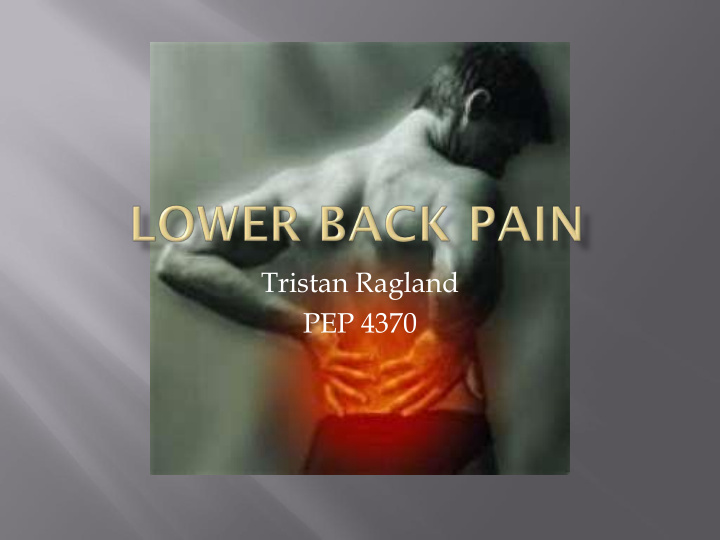



Tristan Ragland PEP 4370
Pain and discomfort, localized below the costal margin and above the inferior gluteal folds, with or without leg pain.
LPB is one of the most widely experienced health-related problems in the world. Lifetime prevalence of LBP is 58 – 70% of the population in industrial countries. Yearly prevalence rate is 15 – 37% At least four out of five adults will experience it at some point in their lives.
Symptoms: Pain: Sharp, dull, aching, ect. Tightness Pain radiating to the legs Lack of flexibility Treatment: Surgery Physical Therapy Medications Nonsteroidal Anti-inflammatory & Nonnarcardic analgesics, Muscle relaxants, antidepressants, Opiates, and Oral Steroids . Exercise
Effects on the Exercise Response In and of itself LBP doesn’t have an effect on the exercise response Exercise positions can exacerbate pain The client’s beliefs can effect their ability. May cause clients to not try to do their best out of fear Clients may also feel insecure and fearful of who might be watching.
Beliefs continued: Minor inconvenience, ignore it Stop daily activities and see a doctor Avoid activities that cause pain or expect will cause pain Acute LBP: Less than 3 months in duration Modify activity temporarily Should be back to normal exercise in 1 – 2 days Chronic LBP: More than 3 months in duration Address misconceptions and fears about exercise Motivate to resume activity Exercise and activity strongly recommended
Individuals with LBP should be able to perform all Exercise Tests recommended by ACSM May be limited by actual or anticipated increase in pain Preferred mode of testing is the treadmill
Aerobic exercise is an important part of therapy for LBP Exercise is Significantly effective for LBP Strong evidence shows there is not one specific regimen that is superior Guidelines for LBP are similar to the ACSM guidelines for apparently healthy individuals Goals: Improve health and well-being, exercise tolerance, prevent debilitation caused by inactivity Intensity and duration should be; graded, gradual in progression and time rather than pain contingent Should consider client preference Stretching should also be prescribed for those who show to have tightness in hips and legs.
Two Types: Acute and Chronic A lot of times origin or reason for pain unknown Mode of exercise should vary Motivate and Educate clients who have fear of pain and re-injuy
Durstine, M. P. (2009). ACSM's Exercises Management for Persons with Chronic Diseases and Disabilities. Champaign, IL: Human Kinetics. Edward T. Howley, B. D. (2007). Fitness Professional's Handbook. Champaign, IL: Human Kinetics. McKenzie, R. (1985). Treat Your Own Back. Waikanae, New Zealand: Spinal Publications LTD.
Recommend
More recommend